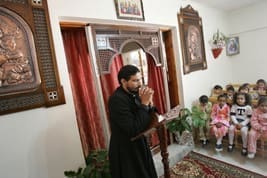Egyptian Christians — known as Copts, a derivative of the Greek word Aigyptios, meaning Egyptian — are proud of their ancient roots. They received the Gospel from St. Mark the Evangelist, who brought the faith to the city of Alexandria, second only to Rome in the ancient Mediterranean world. There, he died a martyr’s death around the year 67.
The evangelist extended his activity beyond the city’s prosperous Jewish community. He called for the city’s populace, mainly Copts and Greeks, to adopt “the way,” the early Christian description for discipleship in Jesus Christ.
Mark sowed the Christian seed on fertile ground. Centuries before the Arab advent in the eastern Mediterranean, and with it the rise of Islam, Egyptian Christianity blossomed. It provided the church with the philosophical foundation and theological vocabulary responsible for its explosive expansion in the Greco-Roman world, introduced monastic life and peopled the universal church with some of its greatest saints and scholars, including Pantaenus, Clement, Origen, Anthony, Macarius, Didymus, Athanasius, Arius, Cyril and Dioscorus.

The Copts today form the largest Christian community in the Middle East. Embracing an estimated 10 percent of Egypt’s population of 88.5 million, the Copts belong to three groups. The majority belongs to the Coptic Orthodox Church. This church developed independently, breaking communion with the churches of Rome and Constantinople, after the Council of Chalcedon (451) attempted to solve the Christological clashes of the early church. Despite centuries of relative isolation and on-again off-again discrimination or persecution, the Coptic Orthodox Church is experiencing a revival.
Throughout the 18th and 19th centuries, European and North American missionaries — Catholic and reformed — competed for influence among the Orthodox Copts, especially after their evangelical efforts among Muslims failed. The goals of these missionaries — to educate the largely illiterate laity, bolster the formation of the clergy and work for the reunion of the churches — were well intended. But their efforts splintered the Coptic Orthodox Church, eventually forming Coptic Catholic and Coptic Evangelical communities.
In the first decades after Vatican II, the Coptic Catholic Church grew considerably. Much of this growth may be attributed to the many social service activities of the Coptic and Roman (Latin-rite) Catholic churches. These include schools (more than 100 parishes sponsor primary and secondary schools), orphanages, clinics and medical dispensaries. Most of these institutions are located in the poorest and remotest villages of the Nile Valley, which remains the center of Coptic Catholic life.
And while for decades relations between the Coptic Orthodox and Coptic Catholic churches had been frosty, the rise of militant Islam and its violent targeting of all Christians has now united all Copts, highlighting what they hold in common: their faith in Christ.
Click here for more on the Coptic Catholic Church from the pages of ONE magazine.